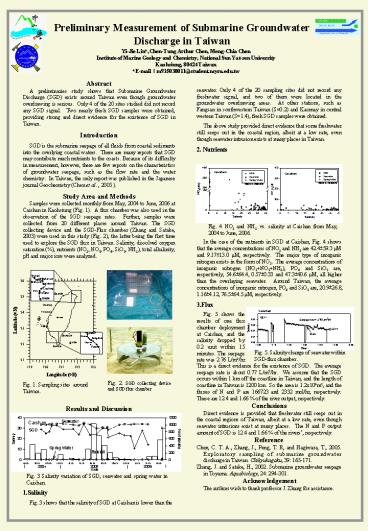Preliminary Measurement of Submarine Groundwater Discharge in Taiwan - PowerPoint PPT Presentation
1 / 1
Title:
Preliminary Measurement of Submarine Groundwater Discharge in Taiwan
Description:
... 2), the latter being the first time used to explore the SGD flux in ... and Discussion. 1. ... 5 shows the results of one flux chamber deployment at Caishan, ... – PowerPoint PPT presentation
Number of Views:48
Avg rating:3.0/5.0
Title: Preliminary Measurement of Submarine Groundwater Discharge in Taiwan
1
Preliminary Measurement of Submarine Groundwater
Discharge in Taiwan
Yi-Jie Lin,Chen-Tung Arthur Chen, Meng-Chia
Chen Institute of Marine Geology and Chemistry,
National Sun Yat-sen University Kaohsiung, 80424
Taiwan E-mailm935030011_at_student.nsysu.edu.tw
Abstract A preliminaries study shows that
Submarine Groundwater Discharge (SGD) exists
around Taiwan even though groundwater overdrawing
is serious. Only 4 of the 20 sites studied did
not record any SGD signal. Two nearly fresh SGD
samples were obtained, providing strong and
direct evidence for the existence of SGD in
Taiwan. Introduction SGD is the
submarine seepage of all fluids from coastal
sediments into the overlying coastal waters.
There are many reports that SGD may contribute
much nutrients to the coasts. Because of its
difficulty in measurement, however, there are few
reports on the characteristics of groundwater
seepage, such as the flow rate and the water
chemistry. In Taiwan, the only report was
published in the Japanese journal Geochemistry
(Chen et al. , 2005 ). Study Area and Methods
Samples were collected monthly from May, 2004 to
June, 2006 at Caishan in Kaohsiung (Fig. 1). A
flux chamber was also used in the observation of
the SGD seepage rates. Further, samples were
collected from 20 different places around Taiwan.
The SGD collecting device and the SGD-Flux
chamber (Zhang and Satake, 2003) were used in
this study (Fig. 2), the latter being the first
time used to explore the SGD flux in Taiwan.
Salinity, dissolved oxygen saturation (),
nutrients (NO3, NO2, PO4, SiO2, NH3), total
alkalinity, pH and major ions were analyzed.
Results and Discussion
1.Salinity Fig. 3 shows that
the salinity of SGD at Caishan is lower than
the
seawater. Only 4 of the 20 sampling sites did not
record any freshwater signal, and two of them
were located in the groundwater overdrawing
areas. At other stations, such as Fangsan in
southwestern Taiwan (S0.2) and Kaomay in central
western Taiwan (S1.4), fresh SGD samples were
obtained. The above study provided direct
evidence that some freshwater still seeps out in
the coastal region, albeit at a low rate, even
though seawater intrusion exists at many places
in Taiwan. 2. Nutrients In
the case of the nutrients in SGD at Caishan, Fig.
4 shows that the average concentrations of NO3
and NH3 are 42.459.3 µM and 9.1713.0 µM,
respectively. The major type of inorganic
nitrogen exists in the form of NO3. The average
concentrations of inorganic nitrogen
(NO3NO2NH3), PO4 and SiO2 are, respectively,
54.664.4, 0.570.33 and 47.340.6 µM, all higher
than the overlaying seawater. Around Taiwan, the
average concentrations of inorganic nitrogen, PO4
and SiO2 are, 20.926.8, 1.164.12, 76.564.5 µM,
respectively. 3.Flux This is a direct
evidence for the existence of SGD. The average
seepage rate is about 0.77 L/m2/hr. We assume
that the SGD occurs within 1 km off the coastline
in Taiwan, and the length of coastline in Taiwan
is 1200 km. So the area is 1.2x109m2, and the
fluxes of N and P are 166723 and 2332 mol/hr,
respectively. These are 12.4 and 1.66 of the
river output, respectively. Conclusions
Direct evidence is provided that freshwater still
seeps out in the coastal regions of Taiwan,
albeit at a low rate, even though seawater
intrusions exist at many places. The N and P
output amount of SGD is 12.4 and 1.66 of the
rivers, respectively. Reference Chen, C. T. A.,
Zhang, J., Peng, T. R, and Hagiwara, T., 2005.
Exploratory sampling of submarine groundwater
discharge in Taiwan.
Chikyukagaku, 39 165-171. Zhang, J. and Satake,
H., 2002. Submarine groundwater seepage in
Toyama. Aquabiology, 24 294-301.
Acknowledgement The authors wish to thank
professor J. Zhang for assistance.
Fig. 4 NO3 and NH3 vs. salinity at Caishan from
May, 2004 to June, 2006.
Fig. 5 shows the results of one flux chamber
deployment at Caishan, and the salinity dropped
by 0.2 unit within 15 minutes. The seepage rate
was 2.76 L/m2/hr.
Fig. 5. Salinity change of seawater within
SGD-flux chamber.
Fig. 2. SGD collecting device and SGD flux chamber
Fig. 1. Sampling sites around Taiwan.
Fig. 3 Salinity variation of SGD, seawater and
spring water in Caishan.































